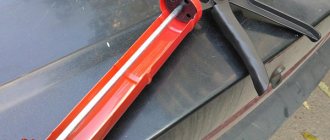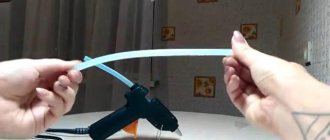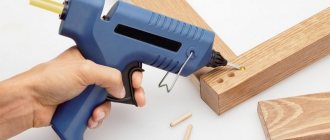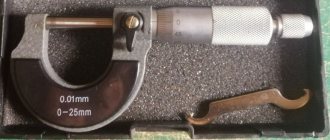When installing plastic windows, doors, as well as sealing seams and insulating buildings, polyurethane foam is used. It is divided into household and professional, and is a special liquid that solidifies upon contact with oxygen. To work with professional cylinders, a tool called a mounting gun is produced. Not many craftsmen know how to use a foam gun, so you have to understand this in detail.
Foam gun design details and operating principle
Before you master the use of a foam mounting gun, you will need to understand the internal structure and operating principle of this tool. The main design elements of the device in question are the following parts:
- Handle – used to hold the device in your hand, making it easier to use
- The trigger or trigger is an element that, when pressed, releases foam from the container
- The barrel is an elongated cylindrical tube, inside of which there is a channel for transporting a liquid substance from the container to the nozzle
- Adapter - a mechanism to which a cylinder with polyurethane foam is attached when using it
- The adjustment screw is an additional element that is present on all models of mounting guns. The screw is designed to adjust the speed and volume of foamed liquid supply. When the position of the screw changes, the trigger stroke increases or decreases
The photo below shows the design of the foam gun, indicating the main components.
The tool is operated by hand, so it belongs to the category of hand-held devices. The device is called a pistol due to its external resemblance to a firearm. The adapter for connecting a cylinder with a polyurethane composition is located in the upper part of the tool body. This arrangement is not accidental, since the container must be used upside down to ensure the release of liquid. Having understood the design of the spray foam gun, it will be useful to know the principle of its operation. First, let's look at the cross-sectional design of a spray foam gun.
Next, we will learn in detail what the internal components of the instrument in question are intended for.
- Nozzle or fitting - the tip of the barrel through which the polyurethane composition exits
- The barrel is an oblong part through which the polyurethane mixture is transferred from the adapter to the nozzle
- Needle rod - the internal channel of the barrel through which liquid foam is transported when the trigger is pressed
- Adapter - a device to which a cylinder with a polyurethane composition is attached
- Housing - the base of the device, made of metal or plastic
- Through hole - the inner chamber in which the linings are located
- Liners - connected to needle valve retaining sleeve
- Adjustment screw - designed to adjust the volume and speed of foam output
- A spring is a component of the adjustment mechanism, which, depending on the clamping force, ensures a high or low level of passage of polyurethane liquid
- Handle - an integral part of the body designed to hold the tool in the hand
- Retaining sleeve - connected to the adjusting screw spring and needle valve. Responsible for the quantitative supply of the composition to the nozzle
- Trigger - connected to a needle valve that moves when the part is acted upon
Knowing the external and internal structure of the tool in question, you should find out the operating principle by which the foam mounting gun functions. When the trigger is pulled, the needle valve located inside the tool barrel is displaced. The internal cavity of the barrel has a channel, which is filled with mounting foam when the cylinder is secured to the adapter. The movement of the rod helps to open the channel to the nozzle, as a result of which the passage opens and the release of the polyurethane composition. To adjust the speed and volume of foam supply, there is an adjusting screw (on all models). Its rotation in one direction or the other helps to weaken or compress the spring acting on the fixing sleeve.
This is interesting!
Polyurethane or polyurethane foam has another name - polyurethane foam sealant. This chemical composition received the name sealant due to its properties and application features.
Price-quality ratio
Depending on the material used, the manufacturer’s company, and whether the gun is collapsible or not, its price depends. For example, a non-separable pistol with plastic parts costs 350 rubles, and the same one with metal parts costs up to 1200. A collapsible version with metal parts costs from 1500 to 2500 rubles.
Considering the great competition in the market, all companies producing foam guns strive to produce only high-quality tools. They will also improve them using new technologies. Thus, the KRAFTOOL company used an innovative valve that replaced a ball with a spring at the installation site of the cylinder.
Selecting and purchasing a mounting gun
The non-separable pistol “ZUBR Master”, costing 555 rubles, has proven itself well.
Its barrel and valve are made of stainless steel. Professional foam gun Workman 3057610W. The valve body is coated with epoxy resin, and the valve role is played by a Teflon ball. The pistol costs 350 rubles.
The KRAFTOOL GOLD-KRAFT dismountable gun is made of brass coated with Teflon for better cleaning. The barrel and valve of the pistol are made of stainless steel. Its cost is 2440 rubles.
Types of foam guns
Guns for working with mounting sealant are classified into two types - professional and household. Household appliances are often sold together with cylinders of polyurethane foam, and they are intended for one-time use. They are made of plastic or polyethylene, which allows foam to escape from the container. Household foam guns are used exclusively for ordinary cans that are not intended for use with professional equipment.
The advantage of household pistols is that they cost pennies. After use, they cannot be cleaned to be reused. In addition, if you start using polyurethane foam, it should be used up within 20-30 minutes. If this is not done, the gun nozzle will become clogged with the drying polyurethane compound, and it will be impossible to continue working with it.
This is interesting!
Many people do not know that if they start using household foam, they should use it entirely.
You cannot leave a started container for storage, as the foam will dry out inside. It is also impossible to store a container of foam for a long time, which will lead to the loss of its technical properties. The most common case of long-term storage of a foam container is a decrease in the volume of polyurethane liquid. Professional guns for polyurethane foam are the devices discussed in the material. The main advantage of such devices is that they are reusable. But first things first:
- Material of manufacture - to create professional guns for working with polyurethane foam, metal and plastic are used. Moreover, cheap device options are made from cheap materials, while expensive ones involve the use of high-quality metal and impact-resistant plastic.
- Disassembly - To ensure that the tool can be reused, the internal parts must be cleaned after use. For this purpose, the device is made dismountable, which allows, if necessary, to disassemble it in order to clean or replace faulty parts. To clean the foam composition inside the gun, you will need special dissolving liquids. However, such liquids are powerless if the polyurethane composition has dried out.
- Used to work with special cylinders. To operate a foam spray gun, it is important to consider the selection of the appropriate cylinder. They differ from a regular cylinder for a household gun in the presence of a threaded adapter. Using this threaded adapter, the cylinder is fixed to the gun adapter, ensuring a tight connection
Knowing the differences between the types of foam guns, you should understand in which case it is recommended to choose the appropriate options.
- To perform one-time work on blowing out cracks in walls or other structures, it is recommended to choose cylinders with polyurethane foam and disposable guns. After the cylinder is used up, it should be disposed of along with the plastic tool.
- If it is necessary to install a window frame, carry out sealing, insulation and other types of manipulations, then you should choose cylinders with polyurethane foam for professional guns. The use of a special tool affects not only the convenience of work, but also the efficient and economical use of material
When the main differences between household (disposable) and professional devices for working with polyurethane foam are known, an appropriate decision should be made - which is better to use in a particular case.
This is interesting!
Despite the significant differences between the types of mounting guns, they are affordable for everyone. The cost of professional devices for foam ranges from 500 rubles to 3000 rubles.
Popular models and their prices
The following products are popular among professionals and are included in the rating of the highest quality:
- Hilti. This manufacturer offers models for home use and for professional builders. Prices range from 650 to 1200 rubles.
Hilti CF DS1.
- Bison This brand produces all-metal air guns, including those with Teflon coating. Cost from 400 to 1350 rubles.
Bison Turbo 4-06877.
- Blast. Convenient and lightweight aluminum pistols with a plastic handle, easy to use, additionally equipped with replaceable nozzles. The cost is within 700 rubles.
Blast Extra Lite.
- Kraftool. Pneumatic guns of this brand allow you to work with high precision, as they clearly regulate the spray. Prices from 500 to 1150 rubles.
Kraftool Celnometal.
- Soudal. This manufacturer produces models for professional builders. Cost from 1200 to 1600 rubles.
- Workman. Metal guns that can be used for household needs and for installation at a construction site. Cost from 350 to 1750 rubles.
This review will help you choose the best foam gun. Which one is better can be decided solely by experience, but the models listed are among the most common and reliable.
Where and for what are polyurethane foam mounting guns used?
The types of tools under consideration have found their application to perform various tasks. Most often, they are used by window and door installers, as well as builders. Moreover, their use is impossible without special cylinders with a polyurethane composition. Moreover, it should be noted that the polyurethane composition can be used both for sealing and insulation, and for gluing. Let's take a closer look at the purposes for which polyurethane foam is used with a gun:
- Sealing seams and holes that occur when walls are insulated with polystyrene foam or polystyrene foam
- Insulation of window and door openings, as well as elimination of drafts
- Bonding door and window frames, as well as sheets of polystyrene foam and expanded polystyrene when insulating walls
- Sealing joints
- Soundproofing
- Production of various designs, layouts, crafts, etc.
- Blowing out holes when installing air conditioners
- Filling cracks and other voids
The scope of use of foam squeezed out of a cylinder using a mounting gun is not limited to the above description. It is used always and wherever it is necessary to quickly and efficiently eliminate cracks or holes in the walls, from which a draft arises and mold appears. Some even use the material in question to blow out car exhaust pipes, doors, hoods and trunks, which is done in order to teach persistent violators of parking rules a lesson. However, such use of the composition is considered hooliganism, since getting rid of the sprayed and dried composition is quite problematic.
This is interesting!
When using foam, it is important to know one of its features - it is susceptible to losing its properties when exposed to ultraviolet radiation. That is why it is not recommended to apply foam where the sun will shine on it. If cracks or holes are being sealed on the outside of the wall, then after applying the composition, the areas should be covered with plaster.
How to use foam under the gun instructions
After purchasing a mounting gun and a special cylinder with polyurethane liquid, you will need to learn how to use them correctly. There is nothing complicated about how to use foam for a gun, and even a child can handle it. However, children should not be allowed to use polyurethane foam, since despite its harmlessness, the composition is a chemical substance that can cause serious injuries.
Instructions for using a foam mounting gun are as follows:
- The first step is to thoroughly shake the container of polyurethane liquid. Moreover, it is recommended to hold the balloon in your hand upside down.
- If work using foam is carried out outdoors at low temperatures, then the container should first be heated in a warm room. It is not recommended to store cylinders outdoors at sub-zero temperatures
- After these requirements are met, the tool is charged. To do this, remove the protective cap from the cylinder, and then screw the gun on top
- Rotate the gun all the way, you will hear a characteristic sound of air bleed
- After this, you need to take the tool in your hand, and the cylinder will be on top. This is the correct location of the cylinder when using the device. If work is carried out under the ceiling, then you should use a flexible connector, through which the gun remains in the same position
- After the cylinder is connected to the gun, you should pull the trigger and wait for the foam to come out through the nozzle. If necessary, adjust the release rate of the polyurethane composition using the adjusting screw.
- After this, we proceed to directly apply the foam to the required areas. To ensure a better connection of the foam with the surface on which it is applied, it should be moistened with water. Water helps improve adhesive properties. Few people know about this, so the composition is often applied to dusty areas, which leads to a decrease in the quality of gluing, sealing, etc.
- The tip of the tool is pointed directly at the seam and the trigger is pulled. If the foam flows weakly, you should tighten the adjusting screw, opening the nozzle holes to the maximum
- Filling the seams is carried out from the bottom up, while performing zigzag movements
- You should not fill the seam completely, as the foam tends to expand when it dries. This is important to consider, since when drying, the pressure of the material increases, which can lead to deformation of products that are blown with foam.
- If a long-lasting seam is blown with a polyurethane compound, you can find how the foam changes its consistency during the process. To ensure high-quality filling of the seam with foam, the container should be shaken periodically
- After finishing the work, you need to remove the empty cylinder from the gun and wash the device. For this purpose, special cylinders with cleaning liquid are used. A cylinder with a special liquid is screwed into the adapter, after which it is necessary to spray by making 5 short presses on the trigger. In this case, the barrel of the gun is directed towards the surface where the foam was applied. Also keep in mind that the cleaning liquid even corrodes paint, so the best option is to spray it on a concrete or brick wall
The outside of the gun should also be wiped with a cloth soaked in solvent. If it is necessary to check or further clean the tool, it can be disassembled. However, practice shows that there is no need to disassemble the gun if you use cleaning material in a timely manner.
When working with a tool, it is important to use protective equipment, namely:
- Gloves - not cotton
- Glasses
- Working clothes
- Respirator
If foam gets on the skin, do not rub it. To remove foam from the covers, you will need to use a cloth soaked in solvent. Another way to remove polyurethane foam from the skin is to wait until it hardens. It is easier to clean the chemical composition after it has dried than in liquid form. Glasses are needed to protect the eyes from contact with the composition, especially when working near the ceiling. When working with polyurethane foam, a harmful odor is released that is dangerous to humans. That is why, when frequently working with polyurethane foam in unventilated areas, you should use respirators.
Having understood the question of how to use foam under the gun, you can start working with the tool. After finishing the work and washing the device, do not forget to screw the adjusting screw all the way.
This is interesting!
Not all craftsmen know one very important feature of professional pistols, which is the possibility of long-term storage with a canister installed. A mounting gun with an unfinished container of polyurethane foam can be stored for more than a month. But at the same time, it is worth considering one important feature: polymerization of the spring occurs, which subsequently interferes with the normal functioning of the tool. You can store a gun with a charged foam cylinder if it is completely sealed, and if there are places where foam leaks, this will lead to it hardening inside the tool.
Comments4 comments
- Lewis:
03.12.2015 at 04:30I tried different foams, now I take titanium, it’s a good solution, I wash the gun with liquid only after replacing the cylinder with a new one, otherwise I leave it screwed on and that’s it
- Alexander:
08/18/2016 at 21:37
Hello! I purchased a gun with plastic foam adjustment. This regulator is very weak and easy to turn. Is it possible to somehow tighten it so that the adjustment occurs more tightly, otherwise it constantly gets lost? sometimes there is a lot of foam, sometimes it swirls. Thank you
- Nikolaevich:
08/24/2016 at 09:57
In order to correctly answer your question, you need at least a photo of your pistol. There are dozens of modifications produced by various companies, and there are some very good ones with plastic parts, but yours is most likely not one of them and therefore you should hardly count on the possibility of a normal repair. If I understand correctly, you have a loose thread in the rear of the gun. Try turning the adjusting screw all the way out and wrapping some fum tape, used for sealing plumbing threads, around the threaded part. You will select the quantity using the sampling method. The screw will become tighter and will solve your problem for a while. Such repairs can be repeated several times until the gun is completely worn out.
- Le Havre:
05.11.2016 at 07:49
When replacing a cylinder with a new one, pour acetone into the receiver; the next cylinder will not stick. The best guns have a mechanical drive to the needle; if something interferes with the needle, you turn the gun around and with a light blow you cause it to seal. Over the many years of its operation, I lost current as a result of mechanical damage (one was crushed in a car by the trunk lid, the second was dropped from scaffolding 6 m) I work as an installer of PVC and aluminum structures, every day 2-3, otherwise more foam cylinders are used up, before the gun was called Kraftool industrie, at the moment the name has been slightly changed, but who wants to google it =) Yes, if you want to get rid of your problems, then here’s exactly how in the article to heat the cylinders and pump it up with VVD, unforgettable moments are guaranteed, especially this needs to be done in the apartments of clients who have There's about half a million worth of furniture in every room, with wishes of good luck, your Gray =)
How to use foam without a gun - useful tips
Very often, craftsmen wonder how to use foam without a gun. There are times when, after purchasing a foam canister, a disposable pistol is lost. It can not only get lost, but also break, and going to the city and buying a cheap device is expensive and irrational. It will also not be possible to use a professional cylinder gun that is not designed for this purpose, so you need to look for a solution. There is a solution, and then we will clearly look at how to use polyurethane foam without a gun:
- To use a regular foam cylinder without a gun, you will need to prepare two things - a thin tube, the diameter of which must match the cylinder fitting, and a wide washer
- First you need to attach a thin tube to the fitting of the can.
- Place a washer on top of the tube, which should rest against the cylinder mechanism
- By pressing the washer, foam will be supplied from the cylinder through the fitting into the tube, which should only be directed to the required area
If you cannot find a plastic tube, then you should use a flexible hose or insulation from an electrical wire. The video below shows how you can easily use construction foam without a gun.
Another situation is when at the most inopportune moment there is no foam mounting gun at hand. It may get lost, broken, or not found at all. What to do in this case? The main thing is never to panic and turn to the Internet for help, because there are always smart thoughts that will help you get out of various situations. To use a professional foam canister without a gun, you must follow these steps:
- Initially, you should find a trunk through which the polyurethane foam will be released. As a barrel, you can use a flexible hose, tube or insulation from a wire. If a wire is used, the cores should initially be removed from it.
- Next, select a suitable size plastic dowel. The dowel will play the role of a trigger. When choosing a dowel, it is important to pay attention to its upper part, where the “skirt” should be present. This “skirt” ensures a hermetically sealed connection of the part to the foam container.
- Having prepared a hose from the electrical cable, and also using a dowel, you need to connect the two elements. The end of the dowel can be cut off if it is not possible to put the insulation on it from the cable
- After this, all that remains is to attach the resulting homemade structure in the form of a pistol, and resort to squeezing out the foam
Long-term or constant use of foam in this way is very inconvenient, but if you need to use the device for a short time, then every master can handle this task. Below is a video showing how to use polyurethane foam without a gun.
The life hacks described above will help you use a can of polyurethane foam when you don’t have a gun at hand. If you have not yet purchased a device for polyurethane sealant, then next we will consider the features of choosing the right tool.
Kraftool celnometal
Advantages:
- easy care;
- durable copper alloy body;
- removable spout, cleaning kit includes pullers;
- the cylinder is securely attached to the gun body;
- service life up to seven years;
- The gun design is hermetically sealed.
Flaws:
- high price;
- heavy weight;
- the tube is constantly clogged;
How to choose a foam gun
The tool in question has a simple design, so there are no difficulties with either selection or repair. Next, we will consider the main criteria that you should pay attention to in order to choose the appropriate mounting gun for polyurethane sealant.
- Tool manufacturer - choosing tools from well-known manufacturers is a 100% guarantee that the buyer will purchase a reliable device that will last a long time if used correctly
- Material of manufacture - if you come across a completely plastic pistol, then you should refuse to buy it. You should choose tools that are made of metal or metal and plastic. Moreover, the body and handle of the device are made of plastic, and the main working parts are metal.
- Type (collapsible or non-collapsible) - almost all versions of mounting guns are collapsible, which allows for their cleaning, maintenance and repair if necessary. If you see a foam gun that is not collapsible, then it is better not to buy it
- Leak testing is one of the most important parameters. If you buy an initially leaky tool, then in addition to the fact that polyurethane liquid will leak when working with it, you will also not be able to leave it with a charged cylinder for a long time. There are various methods for checking a gun under polyurethane foam, which we will consider in detail. When purchasing, remove the pistol from its packaging and pull the trigger. At the same time, you will hear the characteristic sound of air escaping. This is a sign that the device is sealed and worth buying. If the air does not bleed out, it means someone has already pulled the trigger before you, or the tool is not sealed. You can check this in other ways. To do this, install a flushing bottle on the device and make several presses. After this, inspect all connections. The absence of liquid drips other than the nozzle indicates the serviceability of the device. And the last way to check is after several pulls of the trigger, you need to remove the flushing bottle. The next day, pull the trigger, and if the remaining liquid comes out under pressure, then everything is in order with the tightness of the tool. If it simply leaks, then it is necessary to check the seals and, if necessary, replace them
When choosing, you should also hold the tool in your hand and make sure that it will be comfortable to use. The adjustment screw should move smoothly, and the barrel and channels should be made of stainless steel. Ultimately, you need to compare tool prices. It is not recommended to buy the cheapest one, since the manufacturer saved on parts during its manufacture, so such a device will not last long. The most expensive foam gun should be purchased if you plan to use it often; otherwise, it is not a rational waste of money.
For the manufacture of some parts of the instruments in question, non-ferrous metals such as brass, copper, etc. can be used, which affects the cost of the device. Well-known manufacturers of the instruments in question:
- Matrix
- Hilti
- Atoll
- Kraftool
- Stayer
Now you know not only how to choose a professional spray foam gun, but also which brand of device is best to buy. And be sure to read reviews about certain models on our website or on various forums.
Useful video
So, the reader has managed to familiarize himself with the advantages and some disadvantages of professional and household pistols, and now it will be easier for him to navigate the huge flow of products in this group. You should not buy an expensive professional tool if it is purchased for routine repairs. You should pay attention to a tool with nozzles for polyurethane foam included if you have specific work to do. For example, it is expected that doors, windows will be replaced, or there will be work to be done on the ceiling or in the attic. For those who do not have great strength and endurance, pistols with a large weight are not suitable. Your hand will get tired quickly. And of course, it is better to pay attention to models whose manufacturers provide the longest warranty period. If the manufacturer guarantees for 3-4 months, it is unlikely that such a tool will last long.
Malfunctions of a foam gun and features of its repair
When working with the tool, malfunctions may occur, which will require some knowledge to resolve. Let's look at what malfunctions of a foam gun there are, how they manifest themselves, and how to eliminate them.
- When you press the trigger, the polyurethane consistency does not come out - if the screw on the tool is adjusted, then the reason may be that the internal cavity of the barrel, as well as the adapter channel, is clogged. Disassemble the tool and make sure that its internal parts are not clogged. If the tool is working properly, then the cause may be in the cylinder. Foam does not come out of the gun if the work is carried out in cold weather, and the cylinder has not been previously warmed up to room temperature. Install another cylinder to make sure the device is working properly
- Foam leaks when using the gun - such a malfunction indicates a violation of the tightness. In this case, you should resort to replacing the seals (if any), cleaning the parts, and also coating the threads with epoxy glue. If there is a foam leak, then you should not leave the gun with a charged cylinder for a long time.
- Foam comes out through the nozzle without pulling the trigger. This malfunction indicates that the nozzle has worn out. To repair the mounting gun, the tip must be replaced. First make sure that the adjusting screw is screwed in all the way
- The shut-off valve in the adapter is faulty. The adapter consists of a channel as well as a locking mechanism. When the foam container is removed, the ball-type valve closes, preventing liquid leakage from the instrument. To close the valve, a spring acts on the ball.
When a new cylinder is installed, the fitting rests against the ball, displacing it inward. In this case, the gun is filled with a polyurethane mixture coming out of the barrel. If the spring is worn out (which occurs due to the influence of foam), then when the spent cylinder is removed, the remaining foam will be released from the reducer. This type of malfunction can be solved by replacing the adapter, since manufacturers do not provide the ability to replace one spring.
- When the trigger is pulled, a small amount of foam comes out - This is often caused by a malfunction of the mechanism. Often such breakdowns occur on Chinese foam guns.
To repair, unscrew the adjusting screw and look where the washer is located. Details of the repair can be seen in the video.
Disassembling the tool is not particularly difficult, but it is important to take into account that it is strictly contraindicated to use a vice, as the plastic body of the tool can be damaged. When assembling the gun, it is recommended to use epoxy glue or sealant to improve the tightness of the joints.
If you are buying a foam gun for your home, you should also purchase a cleaning liquid along with it. It should always be used after finishing applying the foam. The liquid allows you to extend the service life of the tool and eliminate the need for frequent repairs or replacement of parts. After reading this material, you will learn the design of the tool, the principle of operation, features of selection, repair and correct use of the device. Give due attention to this simple tool to make your work efficient and productive.
Principle of operation
Before you start, you need to familiarize yourself with the basic principles of using the gun:
- Before installing a new cylinder, you should check the adapter for cleanliness: remove, if necessary, any remaining foam from the previous cylinder, remove dust. The valve ball should be clearly visible.
- The balloon itself must be placed on the floor for a couple of minutes so that the mass settles to the bottom. Without lifting it, place the gun on top: winding is done evenly, distortions are excluded. After opening the built-in valve, it is easy to press the lever: if gas begins to escape, then the device is ready for use.
- Before applying to the main area, you should try to apply a small amount of mass on an inconspicuous part. This is necessary to adjust the feed and set the desired output speed.
- Horizontal filling can be done in any direction, and vertical filling can be done from bottom to top.











